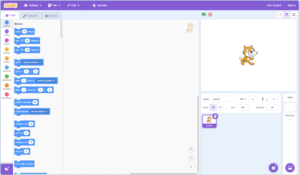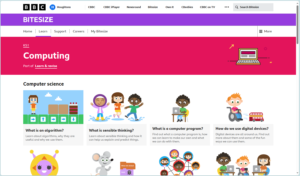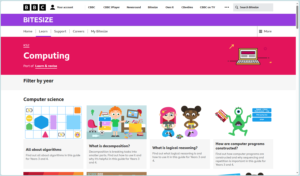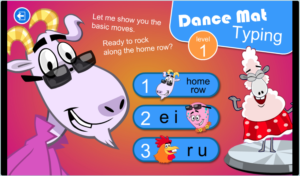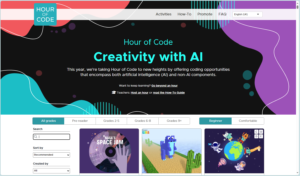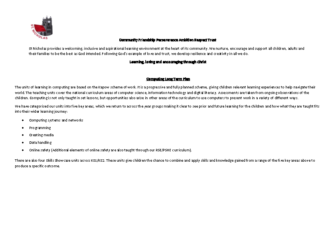Our school curriculum is driven and shaped by our school vision, which informs everything that we do.
St Nicholas provides a welcoming, inclusive and aspirational learning environment at the heart of its community. We nurture, encourage and support all children, adults and their families to be the best as God intended. Following God’s example of love and trust, we develop resilience and creativity in all we do.
Learning, loving and encouraging through Christ.
An uncompromising focus on pupils’ personal development has made St Nicholas Church of England Primary Academy a place where pupils always come first. Ofsted 2019
Computing is an ever growing, integral part of modern-day life. Through the teaching of computing at St Nicholas, we aim to develop independent learners who are equipped with the skills and competencies they need to access digital technology safely and with confidence.
Curriculum Implementation
The national curriculum breaks computing down into three key strands: Computer Science, Information Technology and Digital Literacy. At St Nicholas, using the Kapow curriculum as our foundation, we teach these three strands across five broad areas:
- Computer Systems and Networks
- Programming
- Creating Media
- Data Handling
- Online Safety
Each year, our children revisit these areas, developing their computing knowledge and skills and building on previous learning showing a clear progression of skills. We use a variety of teaching strategies such as independent tasks and paired / group work through a range of unplugged and digital activities.
Children learn about computing systems and networks from EYFS through to year 6, building on their understanding. The children start in EYFS by learning how to log in and log out of the school laptops to enable them to access other programs such as paint. They further develop their understanding in year 1 by improving their mouse skills – learning how to drag, drop, click and control a cursor to create works of art. In year 2, we challenge the children’s understanding of computers as just screens, keyboards and a mouse. They explore what a computer is by identifying the inputs (e.g. keyboards, mouse, touch screens) and outputs (e.g. screens, printers, speakers) and by designing our own computerised invention. Finally, they learn about word processing, developing their typing skills and using simple editing tools including bold, italics, underline and font colour.
In year 3, the children are introduced to the concept of networks, learning how devices communicate with each other and exploring examples of real-world networks. Later in the year, the children learn how to send emails with attachments, being responsible digital citizens by thinking about the contents of what is sent. They also build on their knowledge of computers, looking at the components inside a computer and learning what they do. In year 4, the children learn how we can work collaboratively online with other people across the world. In year 5, we develop the children’s understanding of search engines, thinking about keywords and phrases and learning how results are ranked. Finishing their journey through networks and computer systems, year 6 look at the history of Bletchley Park and investigate code breaking and password hacking skills.
Programming starts in EYFS, with children learning to give and follow simple instructions as part of practical activities and games. They use simple commands they have learnt to experiment with programming a Bee-bot. In year 1, the concepts of algorithms, decomposition and debugging are introduced in unplugged activities, i.e. without using computers, and are related to familiar contexts, such as dressing up, making a sandwich, learning why instructions need to be specific. Later in the year, they put this understanding to the test by further developing early programming skills using Bee-Bots. Year 2 further develop their understanding of algorithms, how they can be programmed and how they can be made more efficient through the introduction of loops. This is put into practice later in the year using simple block programming in ScratchJr.
In year 3, children build on their experience of programming using Scratch, learning to use repetition and build on these skills to program an animation, a story and a game. Year 4 look at variables and how to use them in coding. Later in the year, they use a combination of unplugged and plugged-in activities to develop the four areas of computational thinking – decomposition, abstraction, pattern recognition and algorithm design. Year 5 use their developing programming skills to create music leading to a battle of the bands performance. In a second hands-on unit, they use the BBC micro:bit to learn about the meaning and purpose of programming. Finally, in year 6 the children are introduced to Python, a programming language used in business and industry. They create pieces of art, using nested loops to make their code more efficient.
Starting in EYFS, children use digital cameras to capture images. In year 1, the children build on these skills using their imagination to plan a mini-adventure story, capturing images and enhancing them using a range of editing tools. Year 2 continue to build on these skills by using storyboards and creating simple animations. In year 3, the children develop their storyboarding techniques to create video book trailers using photos, music, transitions, text and voiceovers. In year 4, we begin to look at websites and learn how they are created, working collaboratively to design layouts, embed images and videos and create links between pages. Year 5 build on the animation techniques covered in year 2, using photos to create a video animation. Using all the skills they have learnt throughout the school, in year 6 the children write, record and edit WWII radio plays whilst looking back in time at how computers have evolved.
Data is introduced to the children in Early Years through sorting and categorising objects and using yes/no games (can be compared to branching databases). Year 1 build on this learning by looking at the different ways data can be represented by humans and computers and why data is useful. In year 2, we think about the International Space Station , a fascinating real-world setting for teaching how data is collected, used and displayed.
In year 3, the children learn how a favourite game, Top Trumps, is a paper-based database and we look at the meanings of records, fields and data. The children create their own game and use spreadsheets to sort and filter the data. Year 4 build on this learning, storing weather data on spreadsheets and research how weather forecasts are made. Year 5 learn how computers store data using binary code and use binary to write their names and short messages. In year 6, the children learn about different ways that data can be read by computers, such as barcodes and QR codes and how data can be transmitted. They look at how ‘Big Data’ is being used to design smart buildings to improve efficiency, and the children design their own smart cities.
The children learn about online safety, building on their knowledge and updating their learning throughout their time at St Nicholas in this ever-changing area of computing. From early years through to year 6 the children will look at how to stay safe online, how to manage feelings and emotions online, being responsible online users and learning about our ‘digital footprint’. We cover topics such as understanding privacy settings, protecting our personal information online and navigating the internet in an informed, safe and respectful way.
In KS2, the children learn that online information is not always factual and that fake news is a problem in the online world. They also look at how to deal with online bullying, the negative feelings this produces and exploring ways to overcome this.
For more information about Online Safety at St Nicholas, please visit our Online Safety page.
Our learning
Stop Motion (Year 5)
Video Trailers (Year 3)
Animation (Year 2)
Useful Computing Websites for Children
